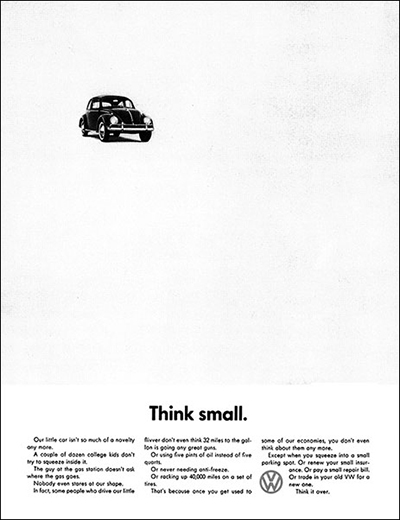The advertising industry has always been a powerful way to connect products and services to potential customers. The combination of visual and verbal elements in advertising has created inspiring campaigns. These campaigns have left a lasting impact on consumers.
One standout example from this golden era of advertising is Volkswagen’s “Think Small” campaign, launched in 1959. Created by the famous advertising agency DDB, this campaign changed the industry. It used simple design and clever, direct writing. This highlighted the Volkswagen Beetle’s simplicity and efficiency. Proving that cleverness and honesty could be more effective than traditional hard-sell techniques.

Another great example is Old Spice’s “The Man Your Man Could Smell Like.” . The ad went viral, thanks to its “stupid-smart” humor. Aiming for a 15% increase in body wash sales, Old Spice saw a 60% rise by May 2010 compared to the previous year. By July 2010, sales had more than doubled, showing a 125% increase. It also set a new benchmark for viral marketing.

Both examples showed that creativity and authenticity can be more persuasive and lasting.
What Has Changed?
Yet, as I reflect on the current state of the advertising industry, I can’t help but notice a shift. There seems to be a decline in the quality of ads. The focus has shifted from well-crafted, creative ads to user generated “ugly ads.” These ads focus on quick results over meaningful engagement.
This shift often focuses on attention-grabbing content that manipulates viewers’ dopamine responses. Ads now often rely on sensationalism, humor, or shock value to capture immediate attention. These ads may engage viewers short-term. But they often lack the depth and creativity needed for lasting consumer connections.
As advertisers chase for numbers, the industry risks losing its depth and authenticity. This shift away from substance undermines what once made ads cool. Together with this, advertisers are no longer culture setters. They follow lowest desires of their younger audiences.
Factors Contributing to the Shift:
New Digital Platforms: The rise of digital platforms transformed advertising consumption. New players like TikTok, with one billion users in four years, are setting new standards. This shift often results in USG content that is less thoughtful and less pleasing.
Data-Driven Decisions: Advertisers often use data analytics and metrics to design ads based on algorithms. This often prioritizes numbers over creativity. Data can enhance targeting and reach. But, it sometimes stifles the creative process by prioritizing numbers over narrative.
Consumer Attention Span: Nowadays, consumers’ attention spans have shortened. Advertisers now face the challenge of capturing attention in a few seconds. This can lead to oversimplified or gimmicky messages that lack depth and creativity.
Tight Budget: Small businesses opt for cheap advertising solutions, sacrificing quality for quantity. This approach results in poor ads.
Setting the Cultural Plank
Despite these challenges, there’s an opportunity for creatives to set a new plank. By embracing the core principles of campaigns like “Think Small” and “The Man Your Man Could Smell Like” we can try to produce work that resonates on a deeper level with audiences. This means focusing on authenticity, storytelling, and emotional connection. It involves prioritizing these elements over following trends or chasing metrics.
Hey, focusing only on numbers instead of meaningful storytelling can make ads shallow. Prioritizing creativity doesn’t mean it will harm results. In fact, smart and creative ads, like those from Old Spice, can boost performance while adding cultural value.
While the advertising landscape developed, the essence of a great ad remains the same.